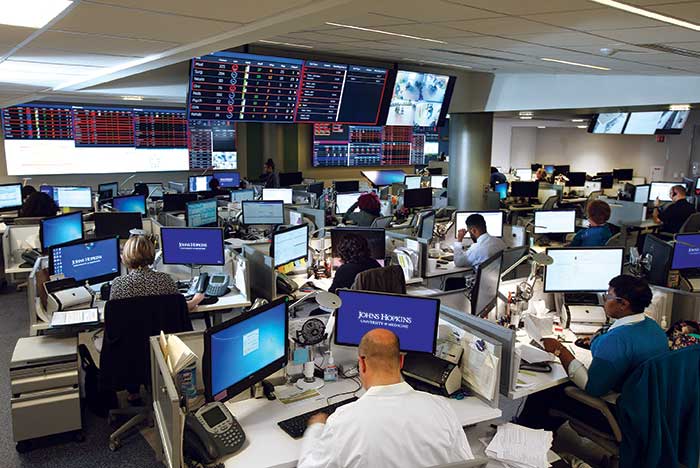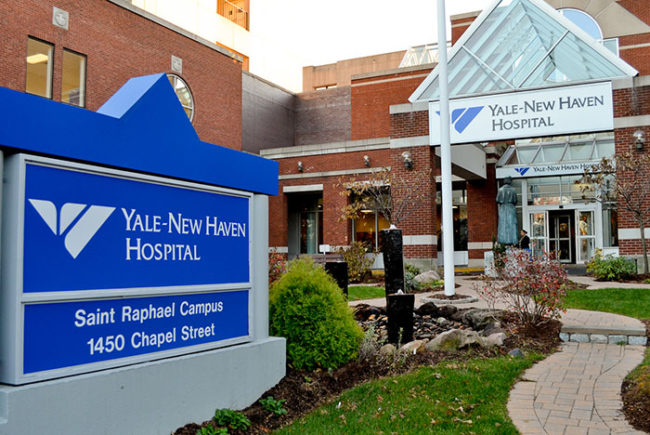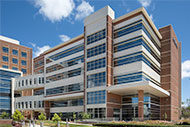
The Judy Reitz Capacity Command Center combines the latest in systems engineering, predictive analytics and problem-solving to better manage patient flow.
A command center launched earlier this year by the Johns Hopkins Hospital, Baltimore, is improving facility operations and patient flow and care by providing real-time predictive analytics to staff who take actions to help the hospital run more efficiently.
Taking a page out of the aerospace and aviation industries, the Judy Reitz Capacity Command Center combines the latest in systems engineering, predictive analytics and problem-solving to better manage patient flow in and through the hospital and other operations. The center was designed and built with GE Healthcare Partners, Chicago.
About 24 staff members from the hospital’s physician referral line, ambulance retrieval system, admitting group and bed management/placement group are now consolidated in the command center instead of being scattered throughout the hospital as before, says Jim Scheulen, chief administrative officer for emergency medicine and capacity management, Johns Hopkins Medicine.
Staff members access an ongoing stream of information shown on nearly two dozen computer monitors known as the Wall of Analytics. During a typical afternoon, the system receives about 500 messages per minute from 14 different Johns Hopkins IT systems or modules generating real-time data. GE built an aggregator that pulls data from the various systems so the command center staff can address issues as they arise.
The staff is informed immediately when there is a sudden influx of patients, the need for possible staffing adjustments, how many patients are being treated, the need to know availability of beds across the hospital, high-priority admissions and discharges, and more.
By continuously accessing and analyzing information flowing in, the staff can prevent or resolve workflow bottlenecks, reduce patient wait time, coordinate services and reduce risk, according to the hospital.
Scheulen raves about the new command center and what it has accomplished since opening about 10 months ago. With 1,000 beds and 100,000 annual emergency department (ED) visits, the new system is invaluable, he notes.
“It’s tremendous,” Scheulen says about the command center. “It’s doing just what it’s meant to do. We’re learning it has more capabilities than we expected, so we are thinking now about how else it can work to smooth out operations.”
Key areas of operational improvement within the hospital include:
- Patient transfers. There has been a 60 percent improvement in the ability to accept patients with complex medical conditions from other hospitals around the region and country.
- Ambulance pickup times. Johns Hopkins’ critical care team is now dispatched 63 minutes sooner to pick up patients from outside hospitals.
- Emergency department flows. A patient is assigned a bed 30 percent faster after a decision is made to admit the person from the ED. Patients are transferred 26 percent faster after they are assigned a bed.
- Operating room transfers. Delays from the operating room after a procedure have been reduced by 70 percent.
- Patient discharges. Twenty-one percent more patients are now discharged before noon compared with that of last year.
“Our capacity command center helps us improve the experiences our patients have when they seek our care, and we are pleased to be among the leaders in this innovation,” Scheulen says.
Prior to opening the command center, the hospital depended on traditional technology such as phones, email and IT systems to manage hospital operations, says Mary Margaret Jacobs, R.N., director of patient/family and visitor services at the hospital.
The command center already has generated abundant interest in the health care field. Since it opened, representatives from 50 health systems across the U.S. and four countries have visited the operation.





